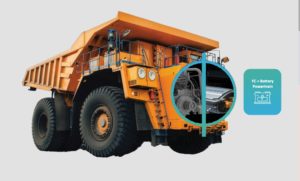Hydra

Challenge
The mining industry is an energy-intensive industry and currently one of the largest CO2 emitters, particularly due to the use of fossil fuels by mining trucks. To achieve the goals set by mining companies, actions need to be taken. Green hydrogen-based energy is one attractive solution. In this context the Hydra project was initiated, with the focus to replace the internal combustion engine of large mining haul trucks (> 200 tonnes) with a hybrid system of hydrogen fuel cells and batteries
To limit global warming to 1.5 degrees Celsius relative to pre-industrial levels, the world will need to achieve net-zero greenhouse gas emissions by around 2050. But to get there, the sectors most responsible for the emissions will need to move fast and start lowering global emissions levels by 2030. Mining companies are conscious of this, and many of the largest miners in the world have been setting increasingly ambitious targets for their CO2 emissions
Haulage trucks are one of the largest sources of emissions in a mine, mostly attributed to diesel consumption.
Research
Hydra aims to use a hydrogen fuel cell-based powertrain for heavy machinery in mining. This will allow the replacement of diesel to achieve the decarbonization goals of the mining industry.
To achieve this goal, various workflows will be carried out, including a pre-feasibility and engineering study of a propulsion system, and the renewable hydrogen value chain. This includes the design, manufacture of a prototype composed by a 60-kW fuel cell and 140 kWh battery which will be tested under mining conditions (altitude, dust, temperature, etc.).
Benefits
- Diesel substitution in hauling applications, the potential to displace 100% of the CO2 emissions
- Refueling time can be competitive against current applications
- Larger autonomy in comparison with other green alternatives
- Lower weight penalty
- Operationally, hydrogen trucks can therefore be deployed on a similar scale to diesel trucks but with the benefit of producing no emissions.
Status
Preliminary Business Case
During 2018-2019, a conceptual study to evaluate the business case for a H2 mining truck solution was successfully completed.
Co-create the Solution (current stage)
Along 2021-2022, the project will carry out the pre-feasibility study and engineering for the H2 mining truck solution, including the H2 supply chain.
In addition, a prototype will be built to evaluate the performance of the FC + Battery powertrain under specific mining conditions.
Both activities will allow us to validate the business case in further detail.
Proof of Concept
By 2024, we expect to be demonstrating the H2 mining truck solution at scale, by swapping the 2MW diesel engine of a mining truck with a fully electric, hydrogen fuel cell + battery powertrain.
Renewable hydrogen will be produced through an electrolysis plant powered by renewable energy.
Scale-up (2026 -2030)
We expect to scale up the H2 mining truck solution, changing an entire fleet of trucks at a specific mining site.
This will help mining companies achieve their decarbonization targets and support the development of renewable hydrogen in Chile, a first crucial step towards becoming a potential renewable H2 exporter.
Partners
Mining companies and operators
- AMSA
- BHP
- Thiess
Hydrogen supply
- Engie : http://engie.mining3.com/hydra/en/
- Mitsui
Technology providers
- Ballard
- Hexagon Purus
- Reborn Electric
- Liebherr
Factsheet
For more detail on the project: http://engie.mining3.com/hydra/en/









